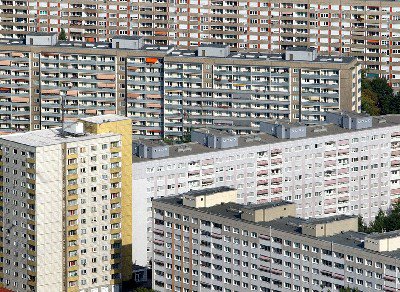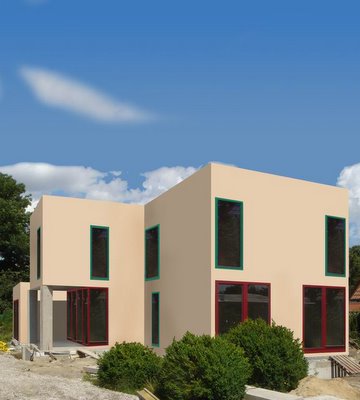Plattenbauten
"Made from prefabricated concrete panels, they were churned out fast and cheap in a handful of blankly functional, almost indistinguishable designs, usually five to 11 storeys high, arranged in long, relentless blocks."

[Image: Germany Online].
They're Germany's Plattenbauten, or towering and monotonous slab houses, and they're increasingly standing empty.
"What to do with a tower block that no one wants to live in?" an article in The Guardian asks. "The solution: pull it down, slice it up, turn it into pleasant family homes."
As Der Spiegel explains: "Eastern Germany's population is shrinking and leaving hundreds of thousands of empty buildings behind. With plans afoot to demolish 350,000 apartments worth of hideous, communist-era buildings made from pre-fab concrete, a Berlin architectural firm is recycling the material into immensely livable single-family homes."
That firm, Conclus, is literally re-using the intact walls, floorplates, and ceilings of these Plattenbauten, putting old modules into new designs, like puzzle pieces. "The only thing we have to do is take the wallpaper off them," says Conclus founder Hervé Biele.




[Images: From Conclus].
Meanwhile it'd be interesting to see if you could take apart the Empire State Building, floor by floor. You could then purchase the 54th floor, and the 54th floor only, and have it transported to you, on a piece of land outside London or in the Scottish Highlands – where you could live in it, floorplan-intact.
Or you could buy an office on the 63rd floor of Taipei 101 – and have it removed, shipped to you in Arizona. The global real estate market becomes a weird spectacle of moving rooms, intact, decontextualized, shipped elsewhere.
(Via Archinect's unflappable Bryan Finoki).

[Image: Germany Online].
They're Germany's Plattenbauten, or towering and monotonous slab houses, and they're increasingly standing empty.
"What to do with a tower block that no one wants to live in?" an article in The Guardian asks. "The solution: pull it down, slice it up, turn it into pleasant family homes."
As Der Spiegel explains: "Eastern Germany's population is shrinking and leaving hundreds of thousands of empty buildings behind. With plans afoot to demolish 350,000 apartments worth of hideous, communist-era buildings made from pre-fab concrete, a Berlin architectural firm is recycling the material into immensely livable single-family homes."
That firm, Conclus, is literally re-using the intact walls, floorplates, and ceilings of these Plattenbauten, putting old modules into new designs, like puzzle pieces. "The only thing we have to do is take the wallpaper off them," says Conclus founder Hervé Biele.




[Images: From Conclus].
Meanwhile it'd be interesting to see if you could take apart the Empire State Building, floor by floor. You could then purchase the 54th floor, and the 54th floor only, and have it transported to you, on a piece of land outside London or in the Scottish Highlands – where you could live in it, floorplan-intact.
Or you could buy an office on the 63rd floor of Taipei 101 – and have it removed, shipped to you in Arizona. The global real estate market becomes a weird spectacle of moving rooms, intact, decontextualized, shipped elsewhere.
(Via Archinect's unflappable Bryan Finoki).





Comments are moderated.
If it's not spam, it will appear here shortly!
cool, man.
i am most unflappably honored.
and, would like to see most prisons broken down into reusable concrete walls and planks, that could be magically reassembled under highways, or in between useless bldg spaces, where some of the excessive underutilized metropolitan crawls can be properly and advantageously scripted, through, (of course), some progressive funky 'squatter architectural recycle and assembly' program. Homes not jails. word, word, and word. But they have also frightening military application, mobile bunker systems, that can be dug in and slapped into the ground almost permanently and within a heartbeat, customfit to the very demands of your particular battlescape. or even, i suppose prefab concrete prisons could be flown and dropped from the sky to all the CIA's secret installation sites. Modular concrete, deployable fortress architecture, instant concrete torture facilities, there was that bag of concrete refugee housing that only required water, and poof voila! emergency shelter. there's spray-on concrete, grancrete, transparent concrete - (ha, can you imagine transparent recylced concrete secret CIA prisons? in some half-assed attempt to humor us about preserving public scrutiny?....I mean who cares if you can see through the walls if there's no one there to see the walls to begin with?), bendable concrete - (oh yeah, imagine the Israel Palestine Barrier Wall eventually being able to bend, to slowly move in accordance with Israeli generals' territorial strategy, border fencing that can slowly encroach, like a concrete snake sidewinding too slow for the naked eye to see, the wall becomes a roving settler machine, or its bends in some places at times to manage certain problem spots and pressure points: bendable border fencing programmed with a territorial mind of its own), uh....crazy applications, all coming together. scary scary and yum yum all at the same time.
Just spotted this bit about plattenbauten. While I applaud the ingenuity that goes into creating new housing from the old blocks , I really hope they all don't get torn down and that the trend spread further afield. I know this sounds wierd but although the blocks are ugly and a terrible way to live I hate to see all the 60's and 70's architecture torn down as it has a certain stark beauty. As much as we hate them they are part of our history
I would think that a bit more attention would be focused on the radical implications of the acts of mining existing structures for materials. In the concrete slab case, materials are extracted in a very high form, meaning they retain the embodied energy (investment) of not only the production of concrete, but also of its forming into slabs. See the links below for images of a project I designed using demolished sidewalk concrete. The poetics here is that the reuse is for stormwater detention weirs. These weirs hold back water that pours off of a 90% impervious watershed. The same sidewalks that once contributed to the stormwater flow are now used to the slow the waters so sedimentation and phytoremediation can occur.
Imagine riprap, interlocking block, and virgin stone being replaced by a harvested material that may reveal indices of past use – a design with ‘worthless’ archeological remnants. (I think of Mark Dion's archeological of unimportant remains.) Reuse of concrete is a creative act of reclamation, building with and out of previous forms that create a mysterious evocation of the past. Not a past of grand Roman ruins, nor even the recent ruins witnessed by Camilo Jose Vergara, but ruins of trash architecture – the seams of a floor from a demolished big box, or a strange block of concrete with variously sized perforations…ductwork?
http://www.tobiahhorton.com/pb/wp_af26a166/wp_af26a166.html?0.12093812877484122
www.flickr.com/photos/16188315@N08/
http://www.superuse.org/story.php?title=Reuse-Sidewalk-Concrete-1
I suggest a quick trip to Aachen, where you can see Charlemagne's throne chair, made of recycled marble slabs and columns.
I wonder if anyone knows which no-longer-useful building was demolished, thus producing the elements of a emperor's throne?
I found this blog (and this entry in particular) because I'm doing some cursory research on my masters thesis, which I hope to focus on political economy of the former DDR - esp. relating to housing projects and urban planning. Anyway, I completely echo the sentiment that Mark expressed above. I believe that's called "ostalgie," no? x
What a waste. Those apartment blocks is where I grew up as a child. They are not ugly or hideous. They are beautiful, and organized.
Taking them down and building those little ugly houses that's in the picture is a complete waste! Who would want to live in an ugly little house like that?
Post a Comment